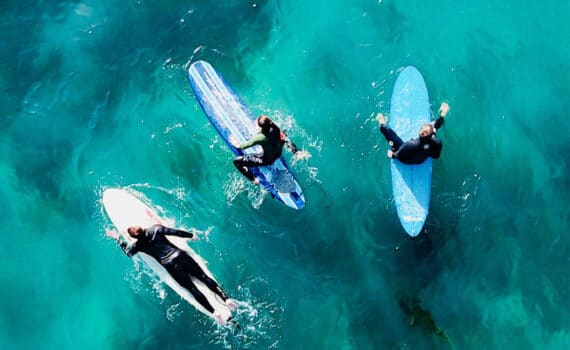1693 words
Surfing stands as the fastest-growing watersport today, evolving dramatically from its birth centuries ago in ancient Hawaii. Modern surf parks and artificial waves grab headlines now, but this thrilling sport’s history runs deep. The surfing industry has grown into a massive $4.1 billion market just for apparel and accessories. Market experts predict this number will reach $5.5 billion by 2032.
The story of surfing’s invention takes us back to times before AI-generated waves and modern technology. Kelly Slater’s perfect wave technology shows how far the sport has advanced from its humble beginnings. The sport has changed so much that 91% of surfers now look for green surf park experiences – a dramatic shift from traditional ocean surfing.
This piece traces surfing’s trip from its spiritual Hawaiian roots to its current position as a technological marvel. The ancient practice has become a global phenomenon that shapes urban development and people’s priorities worldwide.
The Origins of Surfing in Ancient Hawaii
The story of surfing began in Polynesia’s heart, where a special bond with the ocean created what we know as surfing today. Ancient Hawaiians saw “he’e nalu” (wave sliding) as much more than just fun – it surpassed physical activity to become the life-blood of their cultural identity.
Surfing as a spiritual practice
Ancient Hawaiians viewed the ocean as a sacred realm where powerful deities lived. Surfers said prayers before riding waves to ask for protection and good conditions. Making a surfboard was sacred too. Craftsmen chose specific trees (koa, ulu, or wiliwili) carefully. They placed a ceremonial fish near the roots before cutting and prayed throughout the process.
Sacred stone temples called “heiau” stood along the shores. Here, surfers connected with ocean gods through chants and rituals. They believed wave riding let them talk to these deities and brought balance between human and spiritual worlds.
The role of surfing in Hawaiian society
Surfing shaped Hawaiian society in powerful ways. We learned that “ali’i” (chiefs and royalty) controlled the sport, with certain waves and boards being their exclusive domain. The elite rode “olo” boards – long, narrow crafts up to 16 feet long that worked perfectly on gentle, sloping waves.
Common people (“makaainana”) had to use shorter “alaia” boards and could only surf less desirable waves. Anyone caught riding a royal wave faced harsh punishment, even death. A person’s skill at surfing became their way to show strength and earn respect in Hawaiian society.
Who invented surfing: tracing the roots
Surfing’s roots go back to ancient Polynesia around 2000 BC, but Hawaii gets credit for creating “he’e nalu” as we see it today. The oldest signs appear in Polynesian cave paintings that show people riding waves. Hawaii turned surfing into something special – complete with sacred rituals, unique board designs, and deep social meaning.
European missionaries tried to stop surfing in the early 1800s, but they couldn’t wipe it out. On top of that, Hawaiians like Duke Kahanamoku helped rejuvenate surfing and shared it worldwide. Thanks to them, this ancient practice grew into the global phenomenon we see today.
The Global Spread of Surfing
Surfing’s global trip started with an unexpected cultural exchange that changed this ancient Hawaiian practice forever.
European discovery and early fascination
The first documented European contact with wave riding happened in 1777 when Captain James Cook’s crew saw Tahitians riding waves. Lieutenant James King wrote the first description of Hawaiian surfing in 1779. These early European observers watched in amazement. Ship’s surgeon William Anderson noted that a surfer “felt the most supreme pleasure” as the sea carried them smoothly along. Charles Clerke, a ship’s officer, described Hawaiians who skillfully moved their boards “exactly in the Shape of one of our bone paper cutters” and outpaced European boats “in spight of every Exertion of the Crew.”
Surfing’s rise in California and Australia
Surfing stayed in Hawaii until the early 20th century. A key moment happened in 1885 when three Hawaiian princes brought surfing to California. They rode custom-shaped redwood boards at the San Lorenzo River mouth in Santa Cruz. Later in 1907, George Freeth traveled from Hawaii to California and showed surfboard riding as a publicity stunt for Abbot Kinney’s Venice resort.
Duke Kahanamoku became the real force behind surfing’s global spread. This Olympic swimming champion brought surfing to Australia in 1915 and showed his skills at Freshwater Beach in Sydney. His demonstration created excitement that quickly spread along Australia’s coastline. Surfing became so popular in Australia during the 1950s that the government made laws to stop people from surfing during work hours—which made even more people take up surfing.
The birth of modern surf culture
Surfing exploded into mainstream consciousness during the 1960s. This period saw surf music take off, movies like “Gidget” and “The Endless Summer” hit screens, and a unique fashion style emerge. The Beach Boys celebrated surfing’s lifestyle and helped make the sport seem romantic. Bob Simmons and Hobie Alter changed surfboard design with new materials and shapes.
A spiritual Hawaiian practice grew into a global industry. Small surf shops like Quiksilver, Billabong, and Rip Curl became international brands. Professional surfing arrived officially in the 1970s with the creation of what would become the World Surf League.
The Rise of Artificial Waves and Surf Parks
Surfing has come a long way from its ancient rituals to today’s engineering marvels. Artificial wave technology marks the sport’s biggest leap forward. Wave pools now bring this once coastal-only sport to surf enthusiasts far from any ocean.
How wave pools work: from hydraulic jump to Wavefoil
The science of artificial waves builds on the “hydraulic jump” phenomenon—nature’s way of mixing fast-moving water with still water. Today’s wave pools use several clever approaches:
- Piston-powered paddles (Wavegarden Cove): These modular electromechanical systems create up to 1000 waves hourly
- Hydrofoil technology: These underwater devices, shaped like snowplows, move water molecules in circles
- Pressurized air systems: American Wave Machines and others use air pumps to shape different wave types
Kelly Slater’s perfect wave and its effect
Kelly Slater, the surfing legend, showed the world what many call the holy grail of artificial waves—the Surf Ranch in December 2015. This game-changing system pulls a massive hydrofoil through water at 20 mph speeds. Slater himself called it “the best man-made wave ever made”.
The waves pack serious power with faces reaching 8 feet high. The system creates the world’s longest artificial ride that lasts up to a minute. This innovation turned an old waterski park in Lemoore, California into a premier surfing spot.
Surf parks as lifestyle destinations
About 25 dynamic wave pools exist worldwide today, with more than 200 surf parks under development. The number of surf park openings should double each year, according to industry experts.
These facilities have grown beyond simple wave pools into complete lifestyle hubs. URBNSURF Sydney showcases this trend with its 46-module Wavegarden Cove. The facility includes restaurants, a surf academy, leisure pool, skate park, surf store, and wellness center. Surf parks now serve as anchors for property development. Some developers find them more valuable than golf courses for their investments.
The Future of Surfing: AI, Accessibility, and Innovation
Technology keeps reshaping the sport that ancient Hawaiians started by riding wooden boards. The latest wave of state-of-the-art technology takes surfing way beyond natural coastlines into a world where AI improves every part of the experience.
AI-driven wave customization
Wave parks now use AI technology to boost revenue and performance. Wavegarden has revealed CheckMySurf, an AI-based video tracking program that watches individual surfers without wearable devices. The system gives individual-specific feedback and analysis through facial recognition.
Flowstate’s AI system, much like other systems, provides real-time move recognition by analyzing data from over 7.4 million recorded waves. This technology spots specific surfing maneuvers with amazing precision and enables:
- Automated performance assessment
- Better competition scoring
- AI-generated highlight clips for coaching and social sharing
MIT’s engineers have created machine learning models that can predict wave breaking patterns. These models could help design custom waves based on surfer’s priorities.
Making surfing available to landlocked regions
“Landlocked surfers” are becoming more common thanks to artificial wave technology. The sport’s reach was limited by travel costs and logistics for people living far from coastlines.
Wave pools now work as surfing hubs in places that couldn’t surf before. These facilities create consistent waves whatever the location, opening new doors for surfers in continental Europe and America’s central states.
Standing river waves have gained popularity throughout Europe alongside commercial wave pools. These artificial river waves, either naturally changed or purpose-built, bring surfing experiences to places far from oceans.
Sustainability and the next wave of surf tech
Despite technological progress, the surfing industry faces major environmental challenges. New approaches that blend ancient materials with modern techniques have emerged.
Manufacturers now use natural materials like agave plants. These plants provide wood-like material as with balsa but in a more eco-friendly way. RSPro has developed unique cork-based products that stand apart from regular petroleum-based accessories.
The sport sees a “revolution in surfboard fabrication… that is both a blend of futuristic innovation and returning to more traditional materials and methods”. This mix of innovation and tradition will give surfing a future that stays true to its roots. Centuries after its creation, surfing keeps growing while honoring where it came from.
Conclusion – When was Surfing Created
Surfing is evidence of human state-of-the-art progress that keeps its spiritual roots from ancient Hawaii. The sacred practice of “he’e nalu” has grown into an advanced sport over centuries without losing its core essence.
AI-powered wave pools and environmentally responsible manufacturing expand what’s possible in surfing. These advances have made the sport available to more people than its creators could have imagined. Wave parks now bring ocean-quality rides to landlocked areas. AI improves training and helps analyze performance for riders worldwide.
The sport’s commitment to natural materials and environmentally responsible practices shows how surfing welcomes progress while honoring tradition. This balance becomes especially important as the sport grows beyond coastal areas into a $4.1 billion industry. Surfing’s future looks bright. It combines ancestral wisdom with advanced technology to create experiences that honor its past and ride the waves of tomorrow.


